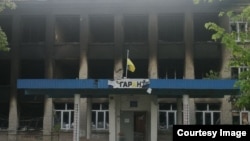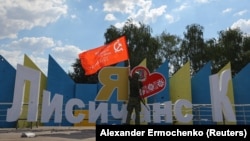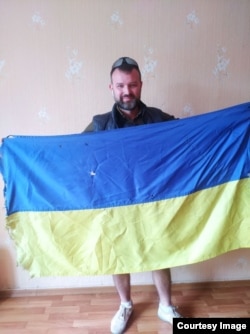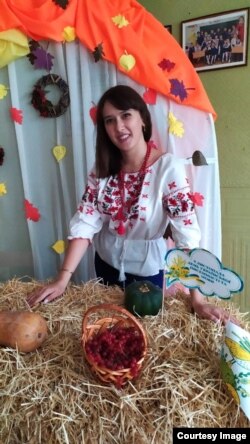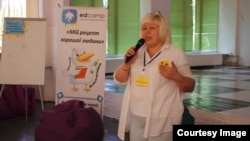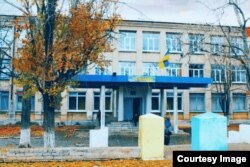KYIV – Svitlana Borovkova has devoted 17 years of her life to the Harant school in Lysychansk, Ukraine, as its principal. On September 1, she would like nothing more than to walk through its doors again to start the new academic year.
But the school is gone, essentially -- almost completely destroyed by shelling in early May that severely damaged its exterior and left the inside gutted by fire.
“My soul was burning along with the school,” Borovkova said, speaking online from another location in Ukraine in mid-August.
By the time the shells hit, she and most of the school’s staff and students had left Lysychansk. By July, the city had been occupied by Russian forces who captured it after prolonged and deadly fighting that left it much of it in ruins.
The seizure of Lysychansk was a key part of Russia’s push to gain control of the entirety of the Luhansk Oblast -- which along with the Donetsk Oblast makes up the region known as the Donbas.
For the vast majority of the school community, returning to Lysychansk remains practically impossible.
“I would either be shot in a square or arrested immediately, because I was on all the hit lists” of the occupying forces, Olesya Dorofyeyeva, a teacher of foreign literature who is also the school’s events coordinator, said via Zoom from the Ivano-Frankivsk region in western Ukraine.
When the school was shelled, French teacher and student media studio director Ivan Shybkov was among the staffers who had already left: He had gotten out with his wife, daughter, and two sons shortly after Russia launched its large-scale invasion of Ukraine on February 24, dramatically widening a war that had persisted in the Donbas since 2014.
Living in a safer part of Ukraine, Shybkov, 35, returned to Lysychansk several times as a volunteer, helping evacuate those willing to leave while leaving was still possible. He was not in the city when it was shelled, and he was shocked by the images and videos of what happened to the school -- so he resolved to go back again to save at least something.
The Ukrainian flag on the school’s porch was the only thing of value that could be recovered, he said.
It wasn’t easy: To get the flag, Ivan had to jump from a window to the porch, risking a long drop to the ground below. But he completed the mission and brought the flag to Dnipro, a government-held city west of the Donbas, and school staffers who were there at the time solemnly unfurled it at the end of the academic year in late May.
“The school is not the walls, but the values that united us,” said Borovkova.
According to the Education Ministry, more than 2,405 educational institutions in Ukraine have been hit by bombs, rockets, or shells, and 270 of them have been completely destroyed. A new requirement this year calls for schools to have fully equipped bomb shelters.
With Harant’s building in ruins and its students, parents, and teachers scattered across Ukraine and beyond by an unprovoked war that has driven at least 12 million people from their homes, Borovkova leading preparations for the new school year – in which will be held entirely online.
She said that, in a small way, the school community is lucky: As a result of the COVID pandemic, an electronic education management system that should allow both classes and administration to flow smoothly online was put in place during the 2021-22 academic year, which was a mix of online and in-person study.
As in schools across Ukraine, the year was proceeding along familiar lines until the invasion on February 24. Soon afterward, Harant ceased operations for a month as teachers, students, and their families first scrambled to escape Lysychansk and then moved from one place to another in search of safety and stability.
But while classes were canceled, the school community stuck together.
“We had a Viber chat where we teachers were always writing, “Do you need help? Are you OK on your own? Write us about where you have moved. Over the whole month we were keeping in touch, so that we could renew distance education, so as not to lose our students,” Dorofyeyeva recalled.
The first online meetings after the forced pause were more about support than education.
“When the first lessons started, we were crying. We were happy that everyone was alive,” Borovkova said.
Emotional Rollercoaster
Dorofyeyeva remembers that period as an emotional rollercoaster for the school community, a rapid succession of highs and lows. And for the students, it was hard to keep up due to difficult, often unsettled circumstances.
“[Parents] were saying, ‘Sorry, our child will not make contact, we will try to do something, but slowly,’ or ‘We are moving,’ ‘We just moved,’ ‘We don’t have Internet,’ ‘Something happened to our phone.’”
As long as cellular service worked in Lysychansk, school administrators also kept in touch with those students who remained in the city.
Natalya Konyukh was not one of them.
Along with her mother, one grandmother, her godmother, and her godmother’s daughter, the 17-year-old escaped Lysychansk on March 6, on an overcrowded evacuation train that was shelled by Russian forces. It was the last train out.
The February invasion came during Konyukh’s final year of high school, but she was already a child of war. In 2014, when fighting broke out in Lysychansk and the Russia-backed forces ruled the city from late May to late July, she was eight years old. Over those two months, before the occupying forces retreated, she and her family stayed in the city, hiding in basements.
“Back then, such military equipment [as has been fired since February invasion] was not involved,” she recalled, saying that the most powerful weapons the Russia-backed forces used were Grad (Hail) rocket launchers.
Growing Up Fast
Konyukh said she grew up fast during that difficult time and stopped thinking like a child. In the ensuing years, she studied hard and took a lot of initiative, proposing and leading several projects for Harant – which goes from 1st grade to the end of high school -- and for Lysychansk.
“Our school was a place where there were no borders between the students, the administration, and the teachers,” she said.
Last winter, as Russia massed tens of thousands of troops near Ukraine’s borders, Konyukh and her peers were planning a performance devoted to women serving in the military. It was to take place at the end of February -- but the invasion spoiled those plans and within two weeks she had fled Lysychansk.
Konyukh took shelter in a city in western Ukraine and immediately joined the volunteer movement there, packing food for displaced people in the area and searching for medicine to be sent to civilians in the war zone.
When classes resumed online, Konyukh returned to her studies. She and 17 other students graduated two months later, and an online ceremony was held.
Now, Konyukh’s plans include studying at a university in western Ukraine and becoming a translator. She has no desire to leave the country, she said, but she doubts she will ever return to live in Lysychansk, where the apartment her family lived has been destroyed.
Her other grandmother, who stayed in the city, will never leave: In June, Konyukh said, “a missile hit the room where she was sleeping” and she was killed.
“I would return there to help and to see my grandmother’s grave, which I haven’t seen, but I would not be able to live there knowing what happened there,” she said, referring to the death and destruction wreaked on the city by Russian forces.
According to Borovkova, many students and their parents say they want to rebuild Harant swiftly “as soon as” Ukraine regains control of Lysychansk. She and others speak in terms of “when” this will happen, not “if,” even though the outcome of the war is unclear and Russian President Vladimir Putin has made control over the Donbas a primary goal.
For now, in any case, the focus is on the school year that starts on September 1.
Harant will have 634 students at the start of the year, the principal said, just 38 fewer than in 2021-22. Some new pupils from other regions are starting at the school. Some students who have left Ukraine will attend two schools -- Harant and an institution in the country where they have taken refuge. As for teachers, the overwhelming majority have stayed with Harant.
Dorofyeyeva is among them. For the 46-year-old, the experience of losing a home and starting from scratch is nothing new. Living in the provincial capital, Luhansk, when the Russia-backed forces seized it in 2014, she fled and found shelter in Lysychansk, where she was born.
She began teaching at Harant in the fall semester of 2014, five months after the start of the Donbas war.
“I had this feeling that I wanted to paint everything in yellow and blue,” she said, referring to the colors of the Ukrainian flag, and “to do everything to say: It’s Ukraine here!”
It was Harant’s initiative to hold a Peace March in the city just after the 2014 occupation. Later, in the years after the Russia-backed forces retreated, Harant led other schools in organizing numerous events emphasizing Ukrainian identity.
“We became the center of Ukrainian-ness in Lysychansk,” Borovkova said.
In Lysychansk, the school stood out.
Borovkova says she started her fight against Russian influence in the city long before the beginning of the Donbas war, which came after Russia fomented anti-Kyiv sentiment across eastern and southern Ukraine following the pro-European, anti-corruption Maidan protests of 2013-14.
She says she had realized years earlier that Russia was exerting influence on the Donbas and promoting narratives that set it apart from the rest of Ukraine.
As early as 2010, Borovkova said, Harant responded by launching media literacy projects and creating student media outlets. This meant that by 2014, when the occupation efforts began, she said, teachers and the students at the school were not subjected to the same level of propaganda as the rest of the city.
She recalled that in May 2014, older students came to her and said that the local TV tower had been seized and was broadcasting propaganda. “The children understood that the propaganda had become very violent, and they worried that both local newspaper and TV were seized by the occupiers,” she said.
Despite the two-month occupation of Lysychansk and the ensuing years of fighting in the Donbas, full-scale war came as a surprise: The school was preparing itself in terms of safety and security, Borovkova said, but she -- like millions of people in Ukraine and elsewhere -- was mentally unprepared.
“Until the last moment, I could not believe that there are people living near who can cause such a disaster to our country,” she said.
Recalling a space-themed birthday celebration on November 30, 2021, she reflected on how much has changed.
“We all [dressed up as] space beings and dreamed of flying to space and making our Earth better…. We were doing waste sorting, we were developing projects, we were [creating student government, a democracy-advancement program for the city, and participating in nationwide initiatives for local communities] -- and we were hoping to continue to live a such happy life,” Borovkova said.
After February 24, priorities changed.
“The great challenge is to keep all the children and teachers,” she said. “For everyone to stay alive.”




